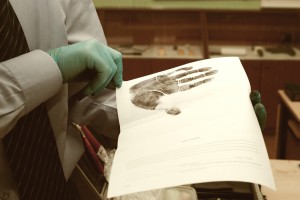 Fingerprints are a common piece of evidence in the judicial system, as they can be used to help identify an individual. While fingerprinting may not be as much of a high-profile method as DNA typing, it’s still a commonly used crime-solving method in criminal investigations.
Fingerprints are a common piece of evidence in the judicial system, as they can be used to help identify an individual. While fingerprinting may not be as much of a high-profile method as DNA typing, it’s still a commonly used crime-solving method in criminal investigations.
Although science cannot validate the notion that no two sets of fingerprints are identical, fingerprints remain a compelling piece of evidence for many juries. Fingerprint evidence by itself, however, is far from infallible and is never treated as sufficient evidence to convict. Most people are aware of fingerprinting either through personal experience or from watching police shows on television, but here we’ll take a bit of a closer look at how fingerprint evidence is obtained and analyzed.
How Do Investigators Find Fingerprint Evidence?
First, it’s important to understand how fingerprints are left behind in the first place. The pad of each finger contains a sort of “map” of contoured whorls and ridges that is completely unique to each individual person. Each ridge on your fingertips contains rows of sweat pores that, as suggested by their name, produce sweat that mixes with dirt and other body oils, leaving an impression on smooth surfaces. Experts use a combination of chemicals and powders in order to make these impressions visible, though the clarity depends on the surface from which the prints are lifted. Incomplete or fragmented fingerprints can be pieced together, however, modern computer enhancement techniques, and laser technology can help recover identifiable fingerprints from almost any surface.
How Are Fingerprints Matched?
Experts sometimes disagree on how many common points are needed in order to declare two sets of fingerprints to be a match. While some will argue that there must be as many as 20 common points before a match can be declared, other experts maintain that a match can be declared on as few as 12 points. Police records and FBI databases include millions of fingerprints to compare different samples, and these prints can be on file for any number of reasons, such as an arrest or someone starting certain occupations. These fingerprints are commonly thought to be reliable in criminal investigations because no two individuals have identical fingerprint patterns, not even identical twins but this is not completely accurate.
Is Fingerprint Evidence Reliable?
While fingerprints are a popular device in daytime TV courtroom dramas, fingerprints are actually matched by an expert and only narrowed down by a computer. The methods used to process fingerprints leave a lot of room for human error, making them less than reliable in a court of law, as an experienced Phoenix lawyer can often find fault with the matching process.
Fingerprint evidence can be very compelling to juries, so it’s always a good idea to have experienced legal representation to point out any flaws that may lead to a false conviction. Josh Blumenreich is one of the top Arizona criminal defense lawyers and has overcome fingerprint evidence in the past, due to its inherently unreliable nature. If you need legal counsel, call the Blumenreich Law Firm today at (602) 252-2570 or contact us online and get a FREE consultation.






 Espaňol
Espaňol